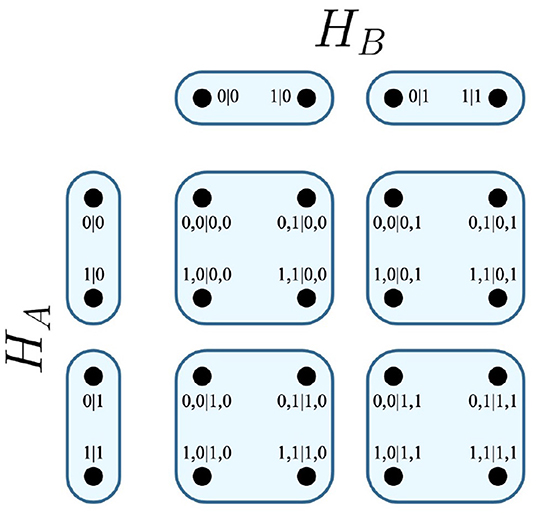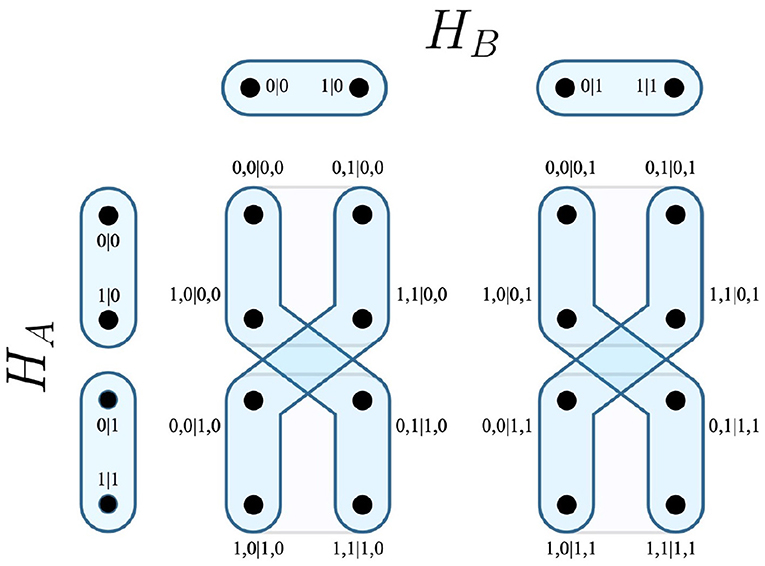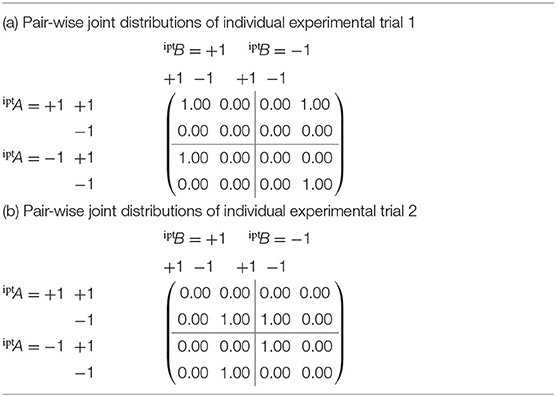- 1ARC Centre of Excellence for Automated Decision-Making & Society (ADM+S), Brisbane, QLD, Australia
- 2School of Information Systems, Queensland University of Technology, Brisbane, QLD, Australia
- 3Digital Media Research Centre, Queensland University of Technology, Brisbane, QLD, Australia
This article extends the combinatorial approach to support the determination of contextuality amidst causal influences. Contextuality is an active field of study in Quantum Cognition, in systems relating to mental phenomena, such as concepts in human memory. In the cognitive field of study, a contemporary challenge facing the determination of whether a phenomenon is contextual has been the identification and management of disturbances. Whether or not said disturbances are identified through the modeling approach, constitute causal influences, or are disregardableas as noise is important, as contextuality cannot be adequately determined in the presence of causal influences. To address this challenge, we first provide a formalization of necessary elements of the combinatorial approach within the language of canonical causal models. Through this formalization, we extend the combinatorial approach to support a measurement and treatment of disturbance, and offer techniques to separately distinguish noise and causal influences. Thereafter, we develop a protocol through which these elements may be represented within a cognitive experiment. As human cognition seems rife with causal influences, cognitive modelers may apply the extended combinatorial approach to practically determine the contextuality of cognitive phenomena.
1. Introduction
Under the assumption that the properties of a system have well-established, pre-existing values prior to measurement, contextuality is when the result of a property's measurement is not independent of the co-properties that are measured along with it (Peres, 1991). However, a key characteristic of contextuality is its inability to be explained by any causal relationship. Consequently, any experiment that declares the presence of contextuality must remove all doubt that the phenomenon is the result of some causal influence. In Quantum Information Science, this requirement is solely fulfilled by the “No-Disturbance” (ND) condition (Ramanathan et al., 2012), which can be experimentally verified by measurement of consistent marginal probabilities, correspondent to the necessary properties. The ND condition was first described in the work of Gleason (1957), who determined the basis of the condition from the physical nature of quantum states. Based on Gleason's work, Kochen and Specker (1975) were able to prove a hypothetical system of orthonormal bases in which no deterministic model of outcomes could be realized that was non-contextual.
It cannot be as easily claimed that the ND condition, let alone “quantum-like” contextuality is inherent to cognitive processes studied within Quantum Cognition. This is because unlike in Quantum Physics, the emergent theories in which the field is grounded do not have any immediate basis in physical properties (i.e., the necessary measurements are mapped to the cognitive experiment by interpretation). For this reason, cognitive modelers have resorted directly to the examination of the associated probabilistic model, for which numerous works have suggested possible frameworks (Aerts et al., 2013; Asano et al., 2014a; Bruza et al., 2015). What has been consistently demonstrated is that disturbance is unavoidably inherent in the probabilistic outcomes of cognitive experiments, and this causes the failure of the ND condition (Dzhafarov et al., 2016). This is not to say that quantum-like contextuality does not appear within cognitive experiments1, as only causal influences falsify the determination of contextuality, and disturbances are not always reduced to causal influences (Atmanspacher and Filk, 2019). But rather, cognitive modelers require a method to adequately distinguish disturbances that are due to causal influences from those that are due to noise, which constitutes the first challenge of this article.
The second challenge addressed in this article is that the vast majority of literature published on the determination of quantum-like contextuality does not consider the convex decomposition of an associated probabilistic model into a set of deterministic models. In turn, this prevents the identification of causal influences within deterministic models that cancel each other out when aggregated into the combined probabilistic model, as articulated in Yearsley and Halliwell (2019)'s criticism of Cervantes and Dzhafarov (2018).
This article develops an experimental protocol that addresses both of the forementioned challenges by the combinatorial approach of Acín et al. (2015). This is realized by two theoretical elements: the Foulis Randall (F-R) product, and the Weighted Fractional Packing Number (WFPN).
Specifically, the F-R product is relevant to the first challenge, as it expresses all causal constraints of the ND condition. Here it is combined with a method developed by Chaves et al. (2015) for assessing the exact amount of causal influence observed in any causal relationship between two observables. In doing so, we realize a process for determining all the disturbances that are only due to causal influences (and not noise) within arbitrary experimental settings, which in turn addresses the first challenge of the article.
With regard to the WFPN, this directly concerns how (non) contextuality is determined in terms of the combinatorial approach, as the cliques enumerated on its graph structure correspond to the deterministic models of the necessary probabilistic model. Acín et al. (2015) relate constraints by Shannon (1956) to said cliques, ensuring that their definition of contextuality remains faithful to the convex decomposition of the relative experiment's probabilistic model, and this overcomes the previously mentioned criticisms of Yearsley and Halliwell (2019). However so, this definition does not yet anticipate the determination of contextuality under the pretense of disturbances, for which it is here adapted, and this addresses the second challenge.
In addressing both of the forementioned challenges, this article produces a novel experimental protocol within the combinatorial approach, for the adequate determination of quantum-like contextuality given the presence of disturbances.
The article proceeds with the following structure: in Section 2, we discuss related work; in Section 3, we relate the EPR framework, a seminal example for modeling contextuality that will assist in the understanding of proceeding sections. In Section 4, we detail relevant definitions of the combinatorial approach; in particular, this section motivates the graph structure of the Weighted Fractional Packing Number (WFPN) as the solution to the previously mentioned challenge concerning convex decompositions of probabilistic models. In Section 5, we introduce key aspects of causal models and diagrams, and substantiate that the ND condition is highly restrictive, as well as that Chaves et al. (2015)'s method is necessary for its relaxation in determining quantum-like contextuality. In Section 6, we declare the necessary mappings to integrate the previously mentioned causal modeling techniques with the combinatorial approach. In Section 7, we prove the main result of the article: a theorem necessary to determine contextuality in the presence of experimental disturbances.
2. Related Work
Within the study of contextuality, there are numerous modeling approaches that stem from distinct interpretations and formalisms of the phenomenon (Isham and Butterfield, 1998; Spekkens, 2005; Asano et al., 2014b; Cabello et al., 2014; Acín et al., 2015; Dzhafarov and Kujala, 2016; Khrennikov, 2021). This work continues upon previous research undertaken by Obeid (2021) in the manner of the combinatorial approach of Acín et al. (2015), for determining quantum-like contextuality amidst causal influences. To the best of our knowledge, the only other line of research that has addressed the forementioned issues for determining of quantum-like contextuality is that of Jones (2019). We perceive that our work is similar in that we consider causal modeling techniques to remedy the issues concerning disturbance, and assume the “no-hidden-influence” principle, as has been articulated in Jones (2021). However, we distinguish our work in that our approach is based within the combinatorial approach of Acín et al. (2015), while the approach of Jones (2019) is based on the probabilistic causal models which are shown to be equivalent to the “Contextuality-by-Default” framework (Dzhafarov and Kujala, 2016).
3. The “Einstein-Podolsky-Rosen” Framework
In Quantum Cognition, the Einstein-Podolsky-Rosen (EPR) framework (Clauser et al., 1969) is one that is largely applied among cognitive modelers in investigations of quantum-like contextuality; for this reason, the framework will be used to convey the results of this paper. The framework involves a system of two parties (A and B), in which each have an input measurement that may be configured to one of two settings (iptA = +1 and iptA = −1 for party A; iptB = +1 and iptB = −1 for party B). In either setting, an outcome is observed as optA = +1 or optA = −1 for party A, or optB = +1 or optB = −1 for party B,. Thereafter, a series of experimental trials are sampled to produce four pair-wise distributions (defined by the input measurements) that communicate the probabilistic outcomes of the experiment:
Definition 1. Four pair-wise joint distributions generated by the EPR experimental framework:
In the adaption of Bruza et al. (2015), the systems corresponded to concepts in a bi-ambiguous conceptual combination, such as “APPLE CHIP”. Each concept would have two senses e.g., “APPLE” has a “fruit” or “computer” sense. Measurements corresponded to priming words given to human subjects who then had to interpret the sense of the associated concept: +1 would indicate that the interpretation aligns with the prime. For instance, if the prime was “banana”, the human subject interpreted “APPLE” in the “fruit” sense. Conversely, −1 would denote the dis-alignment between prime and interpretation (as shown in Table 1).
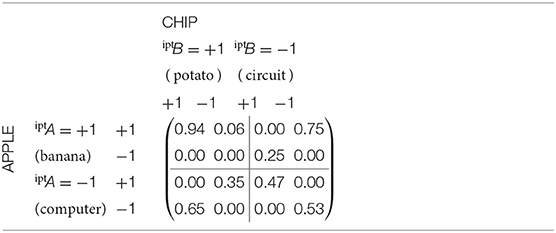
Table 1. Pair-wise joint distributions of conceptual combination “APPLE CHIP” (Bruza et al., 2015).
Contextuality could be determined by a set of inequalities known as the “Bell-CHSH inequalities”, that had been previously conceived by Bell (1964). The inequalities summated the statistical correlations of the pair-wise joint distributions.
Equation 1. The Bell-CHSH inequalities define a violation of the linear system of constraints on the correlations of a probabilistic model:
Note: While there are many expressions of the Bell-CHSH inequalities, the version provided here most closely resembles that taken from Fine (1982).
In the literature, it is common for the maximal statistical correlation of the Bell inequalities to be referred to as the “Bell parameter”, and is typically denoted as . For the EPR framework, the Bell parameter would simply be largest L.H.S. value of any of the lines of Equation (1).
Definition 2. For the EPR framework, the Bell parameter is defined as the maximal statistical correlation recorded for all pair-wise joint distributions of its input measurements.
Furthermore, the R.H.S. of Equation (1) (which is 2 for the EPR framework) is known as the classical bound on the statistical correlations of the Bell inequalities. It is the largest value that can be obtained without violating non-contextual hidden variable theories.
Definition 3. The value is defined as the maximal Bell parameter that can be obtained without violating non-contextual hidden variable theories.
Then, Equation (1) can be simplified to the following expression.
Equation 2. A simplification of Equation (1) that integrates the usage of the Bell parameter.
For the previously mentioned experiment of Bruza et al. (2015), a violation of any of the Bell inequalities would constitute evidence that the concepts are “quantum-like” contextual. While true in principle, this depth of analysis did not identify if the violation of the inequalities was the effect of some causal influence, as pointed out by Dzhafarov et al. (2016); later in this article, a set of techniques will be introduced in the manner of the combinatorial approach to remediate this challenge. Nevertheless, the elements described in the EPR framework demonstrate an experimental specification necessary to investigate quantum-like contextuality, and will consequently be recalled when introducing various preliminaries used to communicate the findings.
4. The Combinatorial Approach
The combinatorial approach of Acín et al. (2015) introduces contextuality scenarios as a hypergraph-based abstraction of a given experiment. The Weighted Fractional Packing Number (WFPN) constitutes the method for determining contextuality within the approach, and it is demonstrated here that the WFPN must be extended in order to support experimental results that exchange disturbances.
4.1. Contextuality Scenarios
For any experiment involving the determination of contextuality, contextuality scenarios offer a hypergraph-based abstraction on which all further procedures are conducted.
Definition 4. For an experiment of n parties, H denotes a system of contextuality scenarios that correspond to the experiment. The relative contextuality scenario of any party i is then a hypergraph Hi, in which its measurements are hyperedges E(Hi), and the possible outcomes of said measurements are vertices V(Hi).
Furthermore, for a hyperedge e ∈ E(HA), a vertex v ∈ e describes an outcome for the measurement, and is notated as v|e. For any party, all outcomes and measurements are conventionally reduced to numerical shorthands, which is reflected within their vertices and edges—the same also applies for joint outcomes among arbitrary parties. Some shorthands relative to the EPR framework are communicated in Table 2.
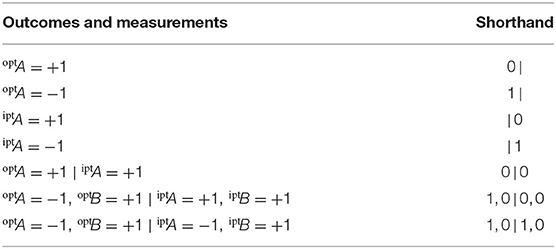
Table 2. Conventional shorthands applied within the combinatorial approach of Acín et al. (2015).
Then, the contextuality scenarios of the parties A and B are hypergraphs HA and HB.
Definition 5. The contextuality scenarios HA and HB for the parties A and B.
4.2. Probabilistic Models
Probabilistic models define the probabilities of experimental outcomes taking place, and correspond directly to the vertices of the relative contextuality scenarios.
Definition 6. For any party i, all possible outcomes that can be generated have weightings attributed to a probabilistic model p that coincides with the relative contextuality scenario Hi: Formally, the probabilistic model of any hypergraph Hi is an assignment of a probability to each vertex v ∈ V(Hi).
4.3. Compositional Products
Compositional products are operations executed on the hypergraphs of one or more contextuality scenarios, in order to assist the determination of contextuality. Further to this detail, the outcome of a compositional product is also a contextuality scenario.
4.3.1. The Cartesian Product
The first compositional product detailed here is the Cartesian product.
Definition 7. For any system of n contextuality scenarios H, the Cartesian product is defined as having the following vertices and hyperedges.
It follows that any edge of the Cartesian product represents one of the possible combinations of joint measurements that can be conducted between the respective parties of the system. In the EPR experiment, the Cartesian product HA × HB is visualized in Figure 1.
4.3.2. Measurement Protocols
In certain cases, it may be necessary to describe the measurements of a given party j as the result of the outcomes of another party i. For this purpose, the combinatorial approach defines measurement protocols.
Definition 8. A measurement protocol EHi→Hj is a hypergraph generated from a function that maps one or more measurements (as hyperedges) of a contextuality scenario Hi to all the measurements (as hyperedges) of another contextuality scenario Hj.
In terms of an experiment, this is taken to mean that for any outcomes associated with a measurement in E(Hi), that a measurement from E(Hj) is consequently chosen. Recalling the EPR experiment, it is possible that the party B may choose their measurements as a function of A's outcomes. The resulting measurement protocol EHA→HB visualizes this relation in Figure 2.
4.3.3. The Foulis-Randall Product
By combining the hyperedges that correspond to all measurement protocols of all parties mapped to all other parties, one is able to describe the measurement of any party as the result of any other party's outcome. These are conveyed by hyperedges of the relative contextuality scenarios, whose vertices correspond to the specific outcomes of such events taking place. This comprises the Foulis-Randall (F-R) product, which is yet another compositional product of the combinatorial approach. For a system of n contextuality scenarios H, the F-R product is expressed as both a hypergraph and a contextuality scenario, and has numerous variations, all of which containing the same vertices as the Cartesian product (see Definition 7). This article is concerned with the common F-R product, which is denoted as .
Definition 9. The hyperedges of the common F-R product are defined as the union of all possible orderings of the commutative, non-associative “⊗” operator on all contextuality scenarios of a system H.
For the EPR framework, the common F-R product would be equivalent to HA ⊗ HB, which is visualized in Figure 3.
4.3.4. The No Disturbance Condition
As a widely tested prerequisite for determining contextuality, the No Disturbance (ND) condition ensures that absolutely no causal influences are mutually exchanged between the parties of the given experiment. This satisfies the requirement that contextuality cannot be due to causal influences. The ND condition is achieved by imposing constraints on the probabilistic weightings of the parties. In terms of the EPR framework, the condition is calculated as follows.
Definition 10. For an EPR experiment involving two parties, A and B, the ND condition requires that given any input measurement by either party, that the probabilistic outcomes must be invariant with respect the outcomes of all other parties.
Within the combinatorial approach, the vertices of the corresponding contextuality scenarios HA and HB convey the outcomes for the respective marginal probabilities of all parties. As such, the probabilities of their joint observation with the edges of all other parties restore the necessary expressions of the ND condition.
Definition 11. For any outcome corresponding to a vertex v of given party HA jointly observed with a measurement corresponding to a hyperedge e of a given party HB, the probability is equivalent to that of the same outcome observed with any other measurement corresponding to a hyperedge e′ of HB. The same applies with respect to all HB's outcomes when jointly observed with measurements of HA.
Furthermore, as the F-R product previously defined each of its hyperedges as corresponding to any party's outcome as a function of another party, it follows that the summated probabilities of said hyperedges would need to be collectively equivalent in order to motivate the assumption that no single causal influence is more probable than another.
Corollary 1. For all hyperedges of the F-R product that corresponds to the EPR framework E(HA ⊗ HB), the summation of all probabilities of any single hyperedge are equivalent to those of any other hyperedge.
4.3.5. Non-Orthogonality Graphs and The Weighted Fractional Packing Number
The WFPN is central to determining contextuality within the combinatorial approach. In order to calculate the Weighted Fractional Packing Number (WFPN), one must first calculate the Non-Orthogonality (NO) graph.
Definition 12. The Non-Orthogonality (NO) graph is defined as a simple graph NO(H) of the same vertices as an input contextuality scenario H, and has hyperedges for vertices that are not within the input's common hyperedges.
Of significance is the NO graph of the F-R product, , for which all maximal cliques C are enumerated.
Definition 13. Let C denote all maximal cliques enumerated upon the NO graph .
Definition 14. The enumeration of the maximal cliques C exemplify all non-contextual deterministic models, and are indexed by a set of weightings q. Then, for any clique c, the corresponding model is attributed the weight qc, which is derived from the total number of times that the model occurs within experimentation, as a percentage of the observation of all possible deterministic models.
In this respect, the WFPN is calculated by constraint of the summation of the weightings q.
Definition 15. The WFPN α* of the F-R product is equivalent to the summation of all weightings of the set q, as indexed by the cliques C.
Finally, the probabilistic model p of the system is recovered by summation of the deterministic models.
Definition 16. For a system of contextuality scenarios H, the probability p(v) of observing any outcome associated with a vertex v ∈ V(H) is equivalent to the sum of the deterministic weightings corresponding to the cliques of C that intersect v.
While the WFPN determines the (non) contextuality of a system, it does so with the assumption that no disturbances are in the experimental results; for this reason, the WFPN must be extended. To do so, we refer to the clique enumeration. As mentioned, this corresponds to all non-contextual deterministic models of the system.
Previous attempts to classify quantum-like contextuality have not taken into account the deterministic decompositions that form their respective probabilistic models: as an implication, experimental disturbances may have influenced the determination of contextuality, despite being overlooked within probabilistic outcomes. Consider an implementation of the EPR framework in which two experimental trials are firstly conducted. Their deterministic models are conveyed by the pair-wise joint distributions in Table 3.
After both experimental trials, the probabilistic model is derived from the normalization of their summated results, as given in Table 4.

Table 4. Pair-wise joint distributions of combined experimental trials from Table 3.
While evaluating the ND condition (Definition 10) on the probabilistic model of Table 4 does not reveal any disturbances, the same does not hold for the deterministic models in Table 3. This is not to say that the observed disturbances in Table 3 constitute causal influences (as Section 5.2.1 will detail that the ND condition is incorrectly provisioned for this task), but that a significant aspect of the determination of contextuality within cognitive experiments has been so far overlooked. This claim has already been made by Yearsley and Halliwell (2019) and Atmanspacher and Filk (2019) for experimentation conducted by Cervantes and Dzhafarov (2018), however a generalization of the method to retrieve all deterministic models has not yet been considered for cognitive experiments. In fact, this can only be achieved by anticipating all deterministic models (such as those of Table 3) for any arbitrary experiment. Only then can a sensitive treatment of the possible disturbances within the corresponding experimental trials be realized. As detailed in Definition 15, all deterministic models of an experiment are retrieved by the enumerated cliques of the WFPN. And this holds for any experiment in which the corresponding contextuality scenarios realize an NO graph, demonstrating where the extension of the combinatorial approach should be realized.
For usage later in later sections of this paper, the following definitions are introduced.
Definition 17. Let all cliques enumerated by the F-R product of a system of contextuality scenarios H be denoted as NCC, as they correspond to the outcomes of all non-contextual deterministic models of the relative system.
Definition 18. Let all possible deterministic models for a system H correspond to the cliques ALLC enumerated on the NO graph of the Cartesian product of the system.
Note: For a system of contextuality scenarios, all its possible deterministic models correspond to the cliques enumerated on the NO graph of its Cartesian product.
By subtracting the cliques NCC from ALLC, we derive the cliques that correspond to the deterministic models that are not non-contextual (i.e., either derived from causal influences or noise). The result will be hereafter denoted as C.
Definition 19. The set of cliques C that correspond to the deterministic models that are not non-contextual are defined as the difference of the set of cliques ALLC and NCC.
Note: Here it is assumed that all cliques derive from operations on the same system of contextuality scenarios.
5. Causal Modeling Techniques
In this section, we detail causal models and diagrams, and argue the failure of the ND condition to distinguish between causal influences and noise for the adequate determination of contextuality amidst causal influences. Furthermore, we relate the work of Chaves et al. (2015) for correctly quantifying causal influences.
5.1. Causal Models and Diagrams
In certain cases, cognitive experiments may appear to determine contextuality by probabilistic weightings, but are in fact non-contextual due to hidden causal influences. To identify said causal influences, one must apply causal modeling techniques, and as such, causal models are here established as necessary. Pearl (2009) defines any causal model as follows.
Definition 20. A causal model M is an ordered triple, in which U represent the set of exogenous random variables, V represent the set of endogenous random variables, and E is the set of causal influences: formally the expressions of the values of V as functions of the values within U and V.
For use in further equations, the set of exogenous and endogenous variables will be unified into a single set.
Definition 21. The set X denotes the union of the sets U and V.
Furthermore, causal models described here assume a canonical probabilistic model (distinct from Section 4.2) attributes weightings to all n members of the set X.
Definition 22. A canonical probabilistic model assigns probabilistic weightings to all random variables X of a causal model.
Causal diagrams provide a visual abstraction of causal models, by ascribing the random variables to a simple graph.
Definition 23. A causal diagram ascribes the random variables within the set X to nodes of a directed acyclic graph . Therein, the directed edges correspond to the causal influences established by the set of expressions E.
Definition 24. The function fpnt defines the causal influences, for which any fpnt(x) of a variable x returns the parent vertex of x within the causal diagram. This defines the set of directed edges .
Equation 3. The joint distribution factors of the random variables within the set X are defined as the product of all probabilities, given observation of the variables associated with their parent nodes in the corresponding causal diagram.
Definition 25. Let the set of all exogenous variables be collected into a latent variable Λ.
5.2. Determining Causal Influences
5.2.1. Association
Failures of purely probabilistic attempts to classify cognitive experiments as determining contextuality are due to modelers relying upon the lowest level, association, of Pearl and Mackenzie (2018)'s ladder of causation in order to identify causal influences.
Equation 4. Association proposes a causal influence from a variable Z to another variable Y by fulfilment of the following probabilistic expression.
This expression can be evaluated by probabilistic weightings alone. At best, association only proves that Y could be caused by Z, vice versa, that both are caused by some other variable, or may be due to noise within experimental results.
It is important to note that while association does not prove any cause for either Y and Z, that it nevertheless is the primary clue that causation may be at play. It follows that imposing constraints upon associations between variables not only restrict all forms of causation, but the experimental noise that is necessary to determine contextuality. Such constraints happen to form the basis of the ND condition.
Proposition 1. The ND condition constitutes a system of expressions that substitute the operator of Equation (4).
Proof: Replace the observation of Y with optA, the observation of Z with iptA, iptB = −1, and the observation of ¬Z with iptA, iptB = +1 in Equation (4). Then substitute the operator with that of equivalence (i.e., “=”) to recover an expression of Definition 10. The same is achieved for any other operation within the ND condition for any combination of inputs. ■
5.2.2. Intervention
In order to determine contextuality for cognitive experiments that may be due to noise, it is necessary to restrict only causal influences. As such, one must refer to the second level, intervention, of Pearl and Mackenzie (2018)'s ladder of causation.
Equation 5. Intervention for a causal influence from some variable Z to another variable Y requires that the experimenter deliberately fixes the protocols that both exhibit and inhibit Z, as denoted by the do operator on a probabilistic expression.
This expression clearly determines whether Y is caused by Z, and cannot be conceptualized by probabilistic weightings alone. Intervention has been detailed in the framework of Chaves et al. (2015), as the necessary technique to differentiate causal influences from noise. And so two equations from the framework are here recalled:
Equation 6. Given intervention on all n variables X of a causal model that are observed under pretense of their parent nodes, the do operator redefines the joint distribution factors as follows.
The second equation2 simply augments Equation (5) with respect to the latent variable Λ, to determine the degree to which Z causally influences Y. In this paper, the expression is generalized.
Definition 26. The expression concerns two variables, Xi and Xj respectively, and returns the direct causal influence that some outcome Xi = k has upon some other outcome .
6. Mapping the Combinatorial Approach to Causal Models
In order for the combinatorial approach to determine contextuality in the presence of experimental disturbances, this section formalizes the necessary causal modeling techniques described in the previous section within the combinatorial approach.
6.1. Contextuality Scenarios
Contextuality scenarios are the fundamental element of the combinatorial approach, and so require a consistent mapping to the random variables of causal models in order to leverage causal modeling techniques. This is no trivial task, as there is no single mapping between them. To demonstrate this point, two separate alternatives will be detailed here in the manner of the EPR framework. The first alternative is motivated from hidden variable theories that precede the discovery of contextuality.
Recalling the EPR framework's experimental settings, consider that each configuration of both parties' input measurements (iptA = +1 and iptA = −1 for party A; iptB = +1 and iptB = −1 for party B) within the experiment maps to the states of two distinct random variables X1 and X3. Thereafter, the outcomes observed (as either optA = +1 or optA = −1 for party A, or optB = +1 or optB = −1 for party B) for either measurement are also distinct random variables X2 and X4. where fpnt(X2) = {X1} and fpnt(X4) = {X3}. This alternative assumes that the outcomes observed by either party are functionally assigned by the configuration of the measurements, and has a causal probabilistic model that is visualized in Figure 4.
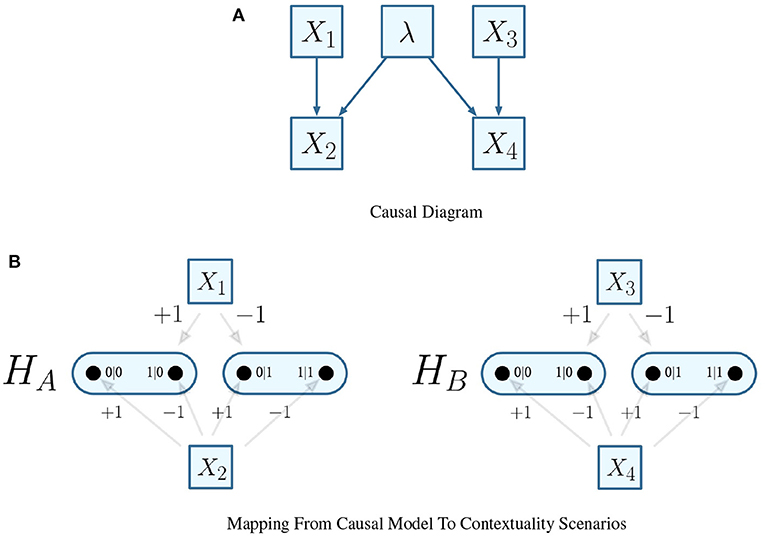
Figure 4. Alternative mapping of causal model to contextuality scenarios with functional assignments. (A) Causal diagram. (B) Mapping from causal model to contextuality scenarios.
The second alternative does not assume functional assignments between random variables, meaning that all causal influences extend from exogenous influences. It implicates a separate interpretation of the experiment: that each dichotomous outcome pertains to its own random variable. In turn, it generates an entirely different system of contextuality scenarios, in which each element of the Cartesian product (which was previously given in Figure 1) has its own random variable.
While both of the forementioned alternatives are entirely possible, the selection depends upon the researcher's own preferences for how physical measurements and outcomes should map to random variables. As measurements and outcomes constitute the edges and vertices of contextuality scenarios, it follows that this will determine the mapping from random variables to contextuality scenarios.
Definition 27. For a system of the contextuality scenarios H, the function fvtc defines a mapping from an outcome Xi = k to the set of vertices e′ that define it within H.
6.2. Causal Influences
As mentioned in Definition 24, causal influences are formalized in causal diagrams as directed edges between random variables.
In terms of contextuality scenarios (and following on from the specification of Section 6.1), the definition corresponds to a relation between two disjoint subsets of the set of vertices V(H) for a system of contextuality scenarios H. This is further specified by the nature of the relation within the causal diagram, for which some possibilities are visualized in the manner of the EPR framework, as shown in Figure 5.

Figure 5. Alternative causal influences. (A) HA measurement to HA outcome. (B) HA measurement to HB outcome. (C) HA outcome to HB outcome.
Considering that Figure 5C conveys the choice of a measurement of one party influencing some outcomes on another party, the combinatorial approach defines these as edges and vertices respectively. Following Figure 5C, suppose one wishes to interrogate whether the highlighted causal influence (i.e., that X1 influences X4), given that X3 = −1. The relation is visualized within the necessary contextuality scenarios in Figure 6.
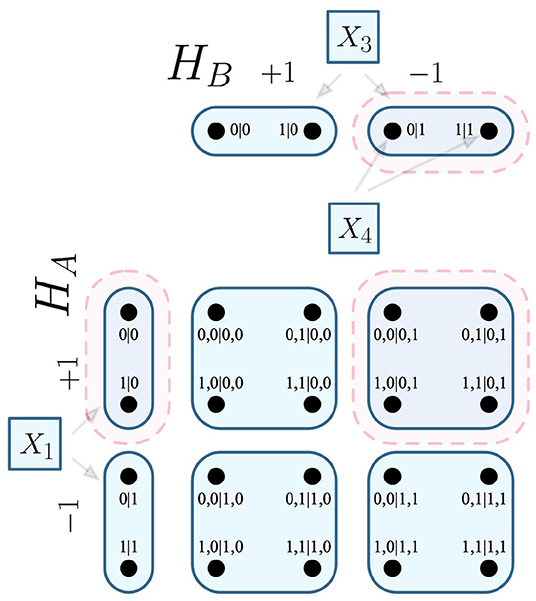
Figure 6. Visualization of relation within Figure 5C, given that X3 = −1. The relation produced by the causal influence (and its derivative hyperedges) are highlighted in red.
In this respect, the full set of causal influences will hereafter be attributed a set R, in which each member details the pair of disjoint vertices that correspond to it.
Definition 28. For a causal diagram , and a system of contextuality scenarios H, let an edge have the source vertex Xi, and the destination vertex Xj. Then the outcomes Xi = k and defines a member r ∈ R.
6.3. Probabilities
As both contextuality scenarios and random variables can share probabilistic assignments, their respective interpretations of probabilistic models are related here.
Equation 7. Any outcome p(v) of the probabilistic model p associated with a system of contextuality scenarios H has an equivalence to the probability of observing one or more of the set of n random variables X.
By Definition 27 and Equation (7), it is possible to recover the probability of observing any single outcome Xi = k.
Equation 8. The probability of observing any single outcome Xi = k is equivalent to the summation of the probabilities of all vertices within the set returned by the function fvtc(Xi = k)
Similarly, the probability of observing any outcome Xi = k, given the observation of any other outcome is given as follows.
Equation 9. The probability of observing any outcome Xi = k, given the observation of any other outcome is equivalent to the summation of the probabilities of all vertices within the set returned by the product of the functions, fvtc(Xi = k) and .
Furthermore, the joint distribution factors are also formalized, relative to the system of contextuality scenario as follows.
Equation 10. Given a variable Xi that has been fixed to the outcome k, the joint distribution factors are expressed in terms of the relative system of contextuality scenarios H. Specifically, the joint distribution only calculates the product over any vertices within V(H) that intersect the corresponding vertices of the outcome fvtc(Xi = k).
7. Determining Quantum-Like Contextuality
In this section, we integrate the elements of the combinatorial approach. and related causal modeling techniques in order to declare the main result of the article: a theorem for determining contextuality within experiments that exchange causal influences.
7.1. Disturbances in Deterministic Models
For any deterministic model that corresponds to a clique c, any edge e of the F-R product always intersects it at exactly one vertex if any only if the model is non-contextual.
Lemma 1. For any deterministic model on a system of contextuality scenarios H whose corresponding clique c is of the set of cliques NCC, the cardinality of the set defined by the intersection of the clique and any edge of the F-R product is always equivalent to 1.
Proof: Firstly, it is known that all hyperedges of the Cartesian product of a system of contextuality scenarios correspond to joint distributions of outcomes. Since any deterministic model only records a single deterministic weighting in any joint distribution of outcomes, it follows that any hyperedge within the Cartesian product will only intersect the clique of the correspondent deterministic model once. Secondly, by Corollary 1 the summated probabilities corresponding to the vertices of any one hyperedge of the F-R product are exactly equivalent to one another. As the F-R product is a superset of the Cartesian product, it follows that any hyperedge of the F-R product will also intersect any clique once, in order to remain consistent with the subset of hyperedges that form the Cartesian product. Furthermore, to prove that Lemma 1 only holds for non-contextual deterministic models, recall that deterministic models that are not non-contextual must violate the ND condition, which imbalances the equality of Corollary 1 by the F-R product. Therefore, it holds that only non-contextual deterministic models can record a single deterministic weighting of 1 in any hyperedge of the F-R product. ■
Then, Lemma 1 can be integrated into the calculation of disturbance for all deterministic models that are not non-contextual, by summating the weightings of q that fail the equality.
Lemma 2. Consider a system of contextuality scenarios H, and the set of weightings q that correspond to all deterministic models indexed by the set of cliques C. For any single clique c ∈ C, its integration with Lemma 1 defines the deterministic weight that constitutes its disturbance. Furthermore, the summation of all such weightings define the absolute total disturbance for exchanged within the system.
Proof: It is known already from Lemma 1 that for a system of contextuality scenarios H, that any member c ∈ NCC intersects any hyperedge of the F-R product in one vertex. Naturally, it follows that that |{c ∩ e}|−1 must always equal zero. In fact, irrespective of all other elements of Lemma 2, if C were substituted with NCC, its clear by the previous point that the entire expression would resolve to zero, validating the fact that deterministic models corresponding to the set NCC do not exchange disturbance. The same should not hold for C, which is supported by the fact that |{c ∩ e}|−1 does not equal zero for members of C. In a simple case, such as the system that corresponds to the EPR framework, |{c ∩ e}|−1 can be either +1 or −1 for any member of C, which is visualized in Figure 7.
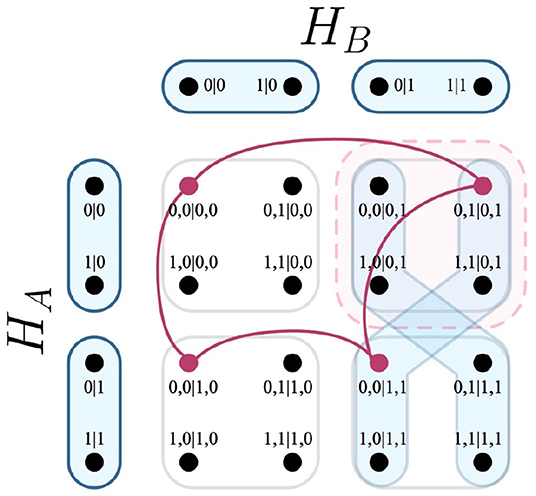
Figure 7. Intersection of a relation, two edges of the F-R product, and a clique. As shown above, the clique c ∈ C (deep red) intersects one edge of the F-R product (light blue) twice, and the other not once. Integrated into the expression |{c ∩ e}| − 1, both edges produce the values +1 and −1, respectively.
If the expression (|{c ∩ e}| − 1) = ±1 were true for arbitrary systems beyond the EPR framework, the expression would detail the total disturbance. However there exist cases where (|{c ∩ e}| − 1) > 1, specifically for deterministic models that exchange disturbance for multiple measurements. Suppose for the EPR framework that the second party were to have three measurements instead of two. A clique c ∈ C could violate the ND condition for two separate outcomes. This would mean that there are two outcomes that exchange disturbance for this model, as visualized in Figure 8.
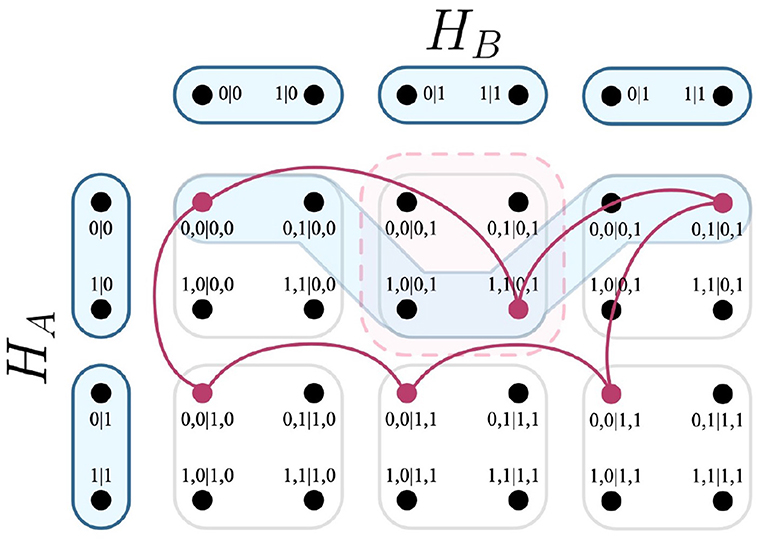
Figure 8. Intersection of a relation, an edges of the F-R product, and a clique within a system that contains three measurements. As shown above, the clique intersects the edge of the F-R product thrice, which evaluates the expression |{c ∩ e}| − 1 to the value +2.
In saying this, the assumption that the disturbance (corresponding to any c ∈ C) is equivalent to 1 would no longer hold. Instead, to correctly quantify disturbances for both outcomes, the ND condition would need to be applied. This is handled by the F-R product, and so Lemma 2 accounts for the total disturbance exchanged within a system. ■
While Lemma 2 defines the expression necessary to calculate the total disturbance exchanged within a system, consider isolating the disturbance for only a single set of measurements from one party onto a set of outcomes of another party. By specification of relations in Section 6.2 and Corollary 1, this is achieved by firstly articulating the edges of the F-R product that capture disturbance for any single relation.
Definition 29. For any relation r ∈ R that corresponds to any causal influence for a system of contextuality scenarios H, the edges of the F-R product necessary for quantifying disturbances on said relation are defined as Er, and are exactly those edges within the necessary measurement protocol that intersect the Cartesian product of the relation.
Then by Definition 29, one can augment Lemma 2 to only quantify weightings that intersect the relation that correspond to the measurements and outcomes in question. Specifically for any probabilistic model, the disturbance on any hyperedge of the F-R product can be evaluated and quantified for whether it corresponds to a relation by the following function.
Lemma 3. Consider a probabilistic model p, a relation r ∈ R, and an edge . Let it be such that all deterministic weightings of the set q form part of the convex decomposition of p, as articulated in Definition 16. Then the total disturbance exchanged between the measurements and outcomes of the relation quantified on the said edge within the probabilistic model are returned by the following function.
Proof: It is known that the Cartesian product of any relation r contains all vertices of its corresponding measurements and outcomes. As any disturbances recorded on said measurements and outcomes can only occur for weightings of q attributed to their respective vertices, it holds that imposing the intersection of by the set Er on the expression of Lemma 2 isolates only the disturbances for said measurements and outcomes. Note that this may include disturbances both to and from the intended parties, as the Cartesian product is agnostic to causal influences. As such, the evaluating hyperedges are fixed to a subset of the F-R product, specifically only those which fit the measurement protocol of the intended source party to the intended destination party. This ensures that only the intended disturbances are captured. ■
7.2. Quantifying Causal Influences
After calculating the total disturbance on a relation, it is possible to finally formalize Definition 26 within the combinatorial approach.
Definition 30. Consider two relations r′ and r″ which correspond to the observation of the outcome Xi = k over another outcome . Let it be such that when Xi = k, that the relative probabilistic model is p′, and that when Xi ≠ k, that the relative probabilistic model is p″. Then the direct causal influence from Xi to Xj is equivalent to the total disturbance observed when Xi = k is fixed minus the total disturbance observed when Xi ≠ k is fixed.
Furthermore, as there is a direct correspondence between the measurements and outcomes, Xi = k and , within and the relation r′, it holds that the shorthand can be used to denote it. Generally, the direct causal influence for any relation r can be denoted by Cr.
Having formalized the direct causal influence for any relation within the combinatorial approach, it is then possible to derive for any experiment the total disturbance that constitutes causal influences.
Lemma 4. For any relation r ∈ R that corresponds to any causal influence for a system of contextuality scenarios, the total direct causal influences that constitute all or part thereof the total disturbances are equivalent to the following expression.
Proof: Firstly, for any relation r, the expression Cr determines (for the general case), the direct causal influence exchanged by the relation. When subtracted from the total disturbance Dr of a given experiment, Dr − Cr quantifies the total noise. This is known because all disturbances that are not the result of causal influences are inevitably the result of noise. In some cases, this may be a negative value (i.e., when there is no disturbance on a relation that anticipates disturbance comprised of causal influence), and so the value is integrated into the expression max{0, Dr − Cr}. Finally, the value is again subtracted from Dr to determine the direct causal influences in the experiment itself. It follows that the summation for all relations quantifies the total direct causal influences for the entire experiment. ■
7.3. Determining Contextuality by Causal Influences
At this stage, it is possible to redefine the equation used to determine quantum-like contextuality. Prior to this work, Pironio (2003) states that for any Bell parameter that violates the Bell inequalities by means of causal influences only, that the amount by which the violation is observed is exactly equivalent to the exchanged causal influences.
Corollary 2. For an experiment that determines contextuality, let the Bell parameter generate its statistical correlation by means of causal influences only (i.e., in the full absence of noise among experimental results). Also, let the weightings of said causal influences be totalled to the value Call. Then it is known by Pironio (2003) that the amount violates the statistical bound is equivalent to Call.
Finally, by rearrangement of Corollary 2 and integration of Lemma 4, we obtain an expression that can determine contextuality in the presence of causal influences.
Theorem 1. For any given experiment, let the Bell parameter generate its statistical correlation against a statistical bound . Then, if the total disturbances for the experiment that constitute causal influences subtracted from the Bell parameter are greater than , the experiment determines contextuality.
By Theorem 1, we can determine contextuality in the presence of causal influences. More importantly, this result allows us to correctly determine quantum-like contextuality within cognitive experiments.
8. An Example Scenario
In this section, an example is provided to convey how the extension of the combinatorial approach determines contextuality in the presence of causal influences. The example again considers the EPR framework, however with a separate probabilistic model that has the pair-wise joint distributions in Table 4.
In the literature, the example is widely known as a “Popescu-Rohrlich” (P-R) box (Popescu and Rohrlich, 1998), and is known to be maximally contextual due to the degree that it's Bell parameter violates the bound of non-contextual hidden variable theories.
Equation 11. The Bell parameter of Table 4 violates the bound of non-contextual hidden variable theories.
Earlier in this article, it was mentioned that results such as the above may be due to causal influences, and may not be truly contextual in nature. By the relevant techniques, an experimental protocol is now detailed.
Let it be such that the experimental trials that inform the probabilistic model of Table 4 have two equally likely deterministic models, which correspond to the cliques seen in Figure 9.
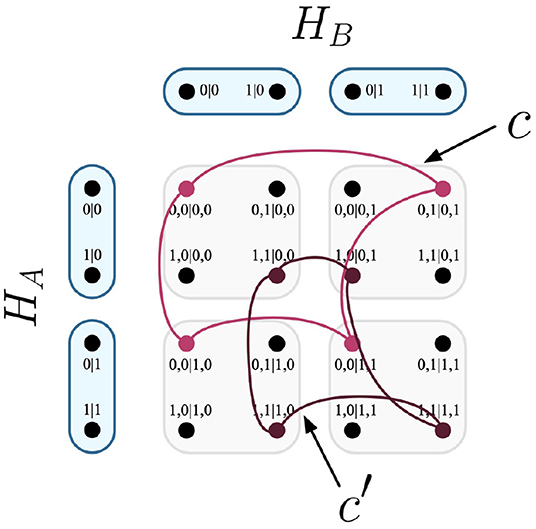
Figure 9. The cliques c and c′ visualized on Cartesian product of contextuality scenarios HA and HB.
Specifically, the cliques would each be attributed equal weightings by the set q.
Definition 31. The set q, conveyed by the two comprising weights that correspond to the cliques in Figure 9:
From either clique, it can be speculated that the outcomes are not invariant with respect to the measurements, and are thus dependent upon their selections. This is evaluated by means of mapping the measurements to a causal model, as previously visualized in Figure 4.
Next, all relations upon the causal model are evaluated; as mentioned in Section 6.2, these correspond to the causal influences that may be present in the model. Of interest, the following relations are considered.
Definition 32. Four relations of set R that are of significance to possible causal influences within the example's causal model:
For the first relation r, we wish to determine the causal influence of observing X3 = −1, given that X1 and X2 are both fixed to the outcomes +1. To do this, we firstly calculate the edges that correspond to relation r by Definition 29.
Definition 33. For relation r from Definition 32, the calculation of edges from the necessary measurement protocol that correspond to the set Er:
Note: In calculating set Er, the comprising values of x and y have been derived by the following additional equations:
Having determined Er in Definition 33, only a single edge of the measurement protocol EHA→HB within the F-R product has been returned. This is visualized in Figure 10.
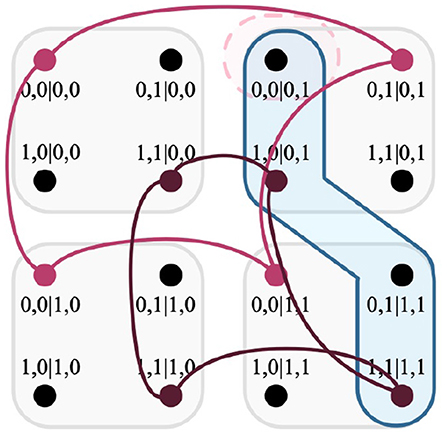
Figure 10. Intersection of cliques, a hyperedge of the F-R product, and a relation. The hyperedge returned by Definition 33 is highlighted in blue; the relation r is highlighted in light red.
Now it is possible to calculate the causal influence variable Cr by Definition 30. As specified, there is a requirement that two separate experimental tests are conducted prior to its calculation, to derive the necessary probabilistic models that correspond to fixing the causal variables to the outcomes of relation r [i.e., Pr(X4 = +1|do(X1 = +1, X2 = +1), X3 = −1)], as well as fixing the causal variables not to the outcomes of relation r [i.e., Pr(X4 = +1|do(X1 = +1, X2 = −1), X3 = −1)]. Coincidentally, the latter case is exactly r′, as detailed in Definition 32. For both relations, the causal variables are significantly fixed, and have separate probabilistic models (p for r, and p′ for r′) informed by their respective experiments. The results, as sampled under the causal interventions are given in Table 5.
With knowledge of p and p′, Cr is calculated by determining the difference in disturbance between the relations r and r′, given their respective probabilistic models. It is known that the F-R product calculates said disturbance, and that by relation r, the edge given in Figure 10 is the only edge that qualifies for the relation; this is the same for the relation r′. What differs between them is that clique c′ does not intersect relation r, which then influences the result of Cr.
Definition 34. The causal influence Cr determined for the relation r, specifically for the causal influence that the configuration of X1 = +1 and X2 = +1 exert upon X4 when X3 = −1.
The same calculation is obtained for all other relations, which for the example reveals the following values:
Definition 35. The causal influence variables, as calculated for all relations of the example:
By Equation (11), the Bell parameter is known to equal 4; also by Equation (1), the statistical bound on non-contextual hidden variables is known to equal 2. In Theorem 1, the value Dr is known to calculate the causal influence of each relation r under the pretense of no causal intervention. For the example, this so happens to be equivalent to the value of causal variable (i.e., Dr = Cr). It follows that the cancelation of values is reflected in the calculation of the theorem below:
Equation 12. The calculation of Theorem 1 for the example scenario given in this section.
As can be seen from the result of Equation (12), the causal influences exchanged between the measurements and outcomes of the respective parties cancel out any indication that the Bell parameter is quantum-like contextual. This concludes the example scenario of how the techniques developed in this article may be applied to more adequately determine quantum-like contextuality.
9. Conclusion
This article has developed and integrated a set of modeling techniques to address the challenges of determining quantum-like contextuality in the presence of causal influences. It has achieved this by firstly addressing the challenge of providing meaningful results to experimentation when disturbances are present, by combination of the F-R product of Acín et al. (2015)'s combinatorial approach and Chaves et al. (2015)'s causal influence formula. The results of this article have also addressed the second challenge of providing a sensitive treatment to the convex decomposition of the probabilistic model associated with an experiment by means of the combinatorial approach's WFPN. This further ensures that hidden causal influences are accounted for within experimental results, as previously recommended by Atmanspacher and Filk (2019). In addressing these challenges, it has furthermore become possible to derive a novel theorem (see Theorem 1) that reasonably adjusts the statistical bound of non-contextual hidden variable theories, allowing for a theoretically consistent determination of contextuality.
Beyond the main objectives of the article, we have also clarified incorrect causal assumptions introduced by the usage of the ND condition within experimentation for determining contextuality. As detailed in Section 5.2.1, it was found that the ND condition can incorrectly classify noise within experimental results as causal influences, which inhibits a meaningful interpretation of experimental results. The article also details how measurements and outcomes (as they are formalized in the combinatorial approach) may be related to canonical causal models. This has been achieved by the necessary mapping functions of causal variables and effects to contextuality scenarios and relations respectively, as detailed in Section 6. Lastly, the article has provided a comprehensive example of how the theoretical contributions may be applied. A protocol detailing the experimental steps has been developed, such that a cognitive modeler may apply them to arrive at a meaningful result. While the example is communicated in the manner of the EPR framework, the theory is generally distilled to be applicable within systems of arbitrarily many outcomes, measurements or parties.
In terms of limitations, it is perceived that this work has only considered integrating the absolutely necessary causal modeling techniques required to produce viable experimental results. We recognize that contemporary approaches to modeling contextuality do not include rigorous causal analyses by nature, and this was evident by the absence of such techniques within the combinatorial approach. However it seems necessary to interrogate causal approaches to study contextuality, which we perceive will further our understanding of the phenomenon. Aside from this, we believe it would also be necessary to adapt Theorem 1 to a linear program that can more generally calculate the statistical bound for any experimental protocol, given the presence of causal influences. It is known in the literature that the statistical bound of the Bell inequalities form a convex polytope of all probabilistic models that adhere to non-contextual hidden variable theories. In saying this, while the methods described in this paper have served the derivation of the statistical bounds necessary to achieve Theorem 1, it is nevertheless possible to extend the findings even further to a more straightforward solution.
Data Availability Statement
The original contributions presented in the study are included in the article/supplementary material, further inquiries can be directed to the corresponding author.
Author Contributions
AO and PB were responsible for the development of the theories necessary to achieve the fundamental results of the paper. AO was primarily responsible for drafting the visual materials and example scenario. All authors were responsible for the proof-reading, grammatical structure, communication of findings, and contributed to the article and approved the submitted version.
Funding
This research has been partially funded by the Unitary Fund, and the Asian Office of Aerospace Research and Development (AOARD) Grant: FA2386-17-1-4016.
Conflict of Interest
The authors declare that the research was conducted in the absence of any commercial or financial relationships that could be construed as a potential conflict of interest.
Publisher's Note
All claims expressed in this article are solely those of the authors and do not necessarily represent those of their affiliated organizations, or those of the publisher, the editors and the reviewers. Any product that may be evaluated in this article, or claim that may be made by its manufacturer, is not guaranteed or endorsed by the publisher.
Acknowledgments
In developing the main findings of this article, We would like to thank Dr. Elie Wolfe for the wealth of guidance he has provided.
Footnotes
1. ^See the experimental results of Basieva et al. (2019).
2. ^Refer to Equation 4 of Chaves et al. (2015).
References
Acín, A., Fritz, T., Leverrier, A., and Sainz, A. B. (2015). A combinatorial approach to nonlocality and contextuality. Commun. Math. Phys. 334, 533–628. doi: 10.1007/s00220-014-2260-1
Aerts, D., Gabora, L., and Sozzo, S. (2013). Concepts and their dynamics: a quantum-theoretic modeling of human thought. Top. Cogn. Sci. 5, 737–772. doi: 10.1111/tops.12042
Asano, M., Hashimoto, T., Khrennikov, A., Ohya, M., and Tanaka, Y. (2014a). Violation of contextual generalization of the leggett–garg inequality for recognition of ambiguous figures. Phys. Script. 2014, 014006. doi: 10.1088/0031-8949/2014/T163/014006
Asano, M., Hashimoto, T., Khrennikov, A., Ohya, M., and Tanaka, Y. (2014b). Violation of contextual generalization of the Leggett–Garg inequality for recognition of ambiguous figures. Phys. Script. 2014, 014006. doi: 10.1088/0031-8949/2014/t163/014006
Atmanspacher, H., and Filk, T. (2019). “Contextuality revisited: signaling may differ from communicating,” in Quanta and Mind (Cham: Springer), 117–127. doi: 10.1007/978-3-030-21908-6_10
Basieva, I., Cervantes, V. H., Dzhafarov, E. N., and Khrennikov, A. (2019). True contextuality beats direct influences in human decision making. J. Exp. Psychol. Gen. 148, 1925. doi: 10.1037/xge0000585
Bell, J. S. (1964). On the Einstein-Podolsky-Rosen paradox. Phys. Phys. Fizika 1, 195. doi: 10.1103/PhysicsPhysiqueFizika.1.195
Bruza, P. D., Kitto, K., Ramm, B. J., and Sitbon, L. (2015). A probabilistic framework for analysing the compositionality of conceptual combinations. J. Math. Psychol. 67, 26–38. doi: 10.1016/j.jmp.2015.06.002
Cabello, A., Severini, S., and Winter, A. (2014). Graph-theoretic approach to quantum correlations. Phys. Rev. Lett. 112, 040401. doi: 10.1103/PhysRevLett.112.040401
Cervantes, V. H., and Dzhafarov, E. N. (2018). Snow queen is evil and beautiful: experimental evidence for probabilistic contextuality in human choices. Decision 5, 193. doi: 10.1037/dec0000095
Chaves, R., Kueng, R., Brask, J. B., and Gross, D. (2015). Unifying framework for relaxations of the causal assumptions in Bell's theorem. Phys. Rev. Lett. 114, 140403. doi: 10.1103/PhysRevLett.114.140403
Clauser, J. F., Horne, M. A., Shimony, A., and Holt, R. A. (1969). Proposed experiment to test local hidden-variable theories. Phys. Rev. Lett. 23, 880. doi: 10.1103/PhysRevLett.23.880
Dzhafarov, E. N., and Kujala, J. V. (2016). “Contextuality-by-default 2.0: systems with binary random variables,” in International Symposium on Quantum Interaction (West Lafayette, IN: Springer), 16–32. doi: 10.1007/978-3-319-52289-0_2
Dzhafarov, E. N., Zhang, R., and Kujala, J. (2016). Is there contextuality in behavioural and social systems? Philos. Trans. R. Soc. A Math. Phys. Eng. Sci. 374, 20150099. doi: 10.1098/rsta.2015.0099
Fine, A. (1982). Hidden variables, joint probability, and the Bell inequalities. Phys. Rev. Lett. 48, 291. doi: 10.1103/PhysRevLett.48.291
Gleason, A. M. (1957). Measures on the closed subspaces of a Hilbert space. J. Math. Mech. 6, 85–893. doi: 10.1512/iumj.1957.6.56050
Isham, C. J., and Butterfield, J. (1998). Topos perspective on the Kochen-Specker theorem: I. Quantum states as generalized valuations. Int. J. Theoret. Phys. 37, 2669–2733. doi: 10.1023/A:1026680806775
Jones, M. (2019). Relating causal and probabilistic approaches to contextuality. Philos. Trans. R. Soc. A 377, 20190133. doi: 10.1098/rsta.2019.0133
Jones, M. (2021). Causal-Model Approach to Contextuality for Disturbing Systems. Available online at: http://pawkur1-qcqmb.home.amu.edu.pl/wp-content/uploads/2021/11/QCQMB-Jones-Nov21.pdf (accessed March 01, 2022).
Khrennikov, A. (2021). Formalization of Bohr's contextuality within the theory of open quantum systems. J. Russian Laser Res. 42, 371–377. doi: 10.1007/s10946-021-09972-3
Kochen, S., and Specker, E. P. (1975). “The problem of hidden variables in quantum mechanics,” in The Logico-Algebraic Approach to Quantum Mechanics (Dordrecht: Springer), 293–328. doi: 10.1007/978-94-010-1795-4_17
Obeid, A. (2021). Modelling contextuality amidst causal influences by means of a computationally tractable combinatorial approach (Ph.D. thesis). Queensland University of Technology, Brisbane, QLD, Australia.
Pearl, J., and Mackenzie, D. (2018). The Book of Why: the New Science of Cause and Effect. London: Basic books.
Peres, A. (1991). Two simple proofs of the Kochen-Specker theorem. J. Phys. A Math. Gen. 24, L175. doi: 10.1088/0305-4470/24/4/003
Pironio, S. (2003). Violations of bell inequalities as lower bounds on the communication cost of nonlocal correlations. Phys. Rev. A 68, 062102. doi: 10.1103/PhysRevA.68.062102
Popescu, S., and Rohrlich, D. (1998). “Causality and nonlocality as axioms for quantum mechanics,” in Causality and Locality in Modern Physics (Dordrecht: Springer), 383–389. doi: 10.1007/978-94-017-0990-3_45
Ramanathan, R., Soeda, A., Kurzyński, P., and Kaszlikowski, D. (2012). Generalized monogamy of contextual inequalities from the no-disturbance principle. Phys. Rev. Lett. 109, 050404. doi: 10.1103/PhysRevLett.109.050404
Shannon, C. (1956). The zero error capacity of a noisy channel. IRE Trans. Inform. Theory 2, 8–19. doi: 10.1109/TIT.1956.1056798
Spekkens, R. W. (2005). Contextuality for preparations, transformations, and unsharp measurements. Phys. Rev. A 71, 052108. doi: 10.1103/PhysRevA.71.052108
Keywords: contextuality, combinatorics, cognition, disturbance, causality
Citation: Obeid AK, Bruza P, Moreira C, Bruns A and Angus D (2022) An Extension of Combinatorial Contextuality for Cognitive Protocols. Front. Psychol. 13:871028. doi: 10.3389/fpsyg.2022.871028
Received: 07 February 2022; Accepted: 25 April 2022;
Published: 20 May 2022.
Edited by:
William Sulis, McMaster University, CanadaReviewed by:
Yoshi Maruyama, Australian National University, AustraliaAndrei Khrennikov, Linnaeus University, Sweden
Copyright © 2022 Obeid, Bruza, Moreira, Bruns and Angus. This is an open-access article distributed under the terms of the Creative Commons Attribution License (CC BY). The use, distribution or reproduction in other forums is permitted, provided the original author(s) and the copyright owner(s) are credited and that the original publication in this journal is cited, in accordance with accepted academic practice. No use, distribution or reproduction is permitted which does not comply with these terms.
*Correspondence: Abdul Karim Obeid, b2JlaUBxdXQuZWR1LmF1
 Abdul Karim Obeid
Abdul Karim Obeid Peter Bruza
Peter Bruza Catarina Moreira
Catarina Moreira Axel Bruns1,3
Axel Bruns1,3 Daniel Angus
Daniel Angus